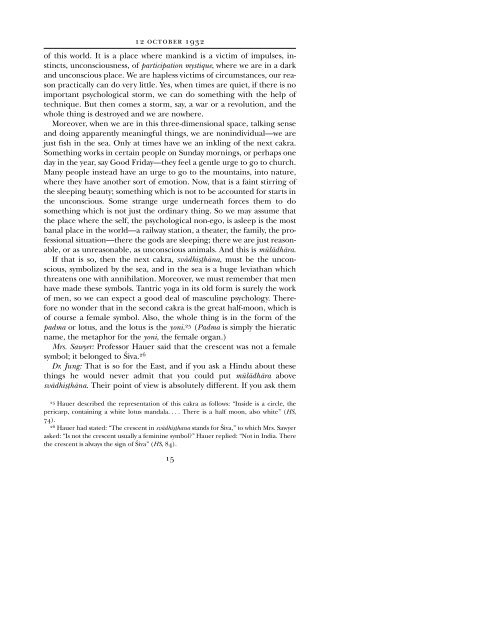CG JUNG - Countryside Anarchist
CG JUNG - Countryside Anarchist
CG JUNG - Countryside Anarchist
Create successful ePaper yourself
Turn your PDF publications into a flip-book with our unique Google optimized e-Paper software.
12 OCTOBER 1932<br />
of this world. It is a place where mankind is a victim of impulses, instincts,<br />
unconsciousness, of participation mystique, where we are in a dark<br />
and unconscious place. We are hapless victims of circumstances, our reason<br />
practically can do very little. Yes, when times are quiet, if there is no<br />
important psychological storm, we can do something with the help of<br />
technique. But then comes a storm, say, a war or a revolution, and the<br />
whole thing is destroyed and we are nowhere.<br />
Moreover, when we are in this three-dimensional space, talking sense<br />
and doing apparently meaningful things, we are nonindividual—we are<br />
just fish in the sea. Only at times have we an inkling of the next cakra.<br />
Something works in certain people on Sunday mornings, or perhaps one<br />
day in the year, say Good Friday—they feel a gentle urge to go to church.<br />
Many people instead have an urge to go to the mountains, into nature,<br />
where they have another sort of emotion. Now, that is a faint stirring of<br />
the sleeping beauty; something which is not to be accounted for starts in<br />
the unconscious. Some strange urge underneath forces them to do<br />
something which is not just the ordinary thing. So we may assume that<br />
the place where the self, the psychological non-ego, is asleep is the most<br />
banal place in the world—a railway station, a theater, the family, the professional<br />
situation—there the gods are sleeping; there we are just reasonable,<br />
or as unreasonable, as unconscious animals. And this is mÖlvdhvra.<br />
If that is so, then the next cakra, svvdhiü°hvna, must be the unconscious,<br />
symbolized by the sea, and in the sea is a huge leviathan which<br />
threatens one with annihilation. Moreover, we must remember that men<br />
have made these symbols. Tantric yoga in its old form is surely the work<br />
of men, so we can expect a good deal of masculine psychology. Therefore<br />
no wonder that in the second cakra is the great half-moon, which is<br />
of course a female symbol. Also, the whole thing is in the form of the<br />
padma or lotus, and the lotus is the yoni. 25 (Padma is simply the hieratic<br />
name, the metaphor for the yoni, the female organ.)<br />
Mrs. Sawyer: Professor Hauer said that the crescent was not a female<br />
symbol; it belonged to åiva. 26<br />
Dr. Jung: That is so for the East, and if you ask a Hindu about these<br />
things he would never admit that you could put mÖlvdhvra above<br />
svvdhiü°hvna. Their point of view is absolutely different. If you ask them<br />
25 Hauer described the representation of this cakra as follows: “Inside is a circle, the<br />
pericarp, containing a white lotus mandala. . . . There is a half moon, also white” (HS,<br />
74).<br />
26 Hauer had stated: “The crescent in svvdhiü°hana stands for åiva,” to which Mrs. Sawyer<br />
asked: “Is not the crescent usually a feminine symbol?” Hauer replied: “Not in India. There<br />
the crescent is always the sign of åiva” (HS, 84).<br />
15


